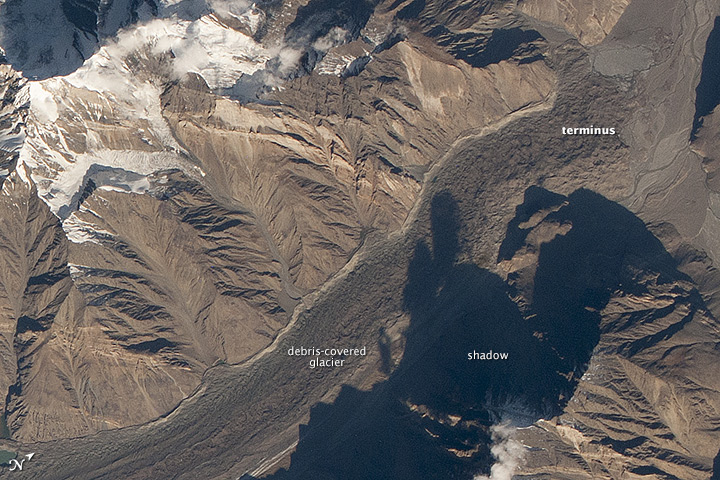


In northern Tajikistan, a long, narrow glacier winds it way north from the ice-capped heart of the Pamir Mountains toward the border with Kyrgyzstan. Stretching 77 kilometers (47 miles), Fedchenko Glacier is the longest glacier outside of the polar regions.
While many glaciers around the world are retreating, an analysis published in 2014 by Russian and German researchers concluded that Fedchenko has been relatively stable during the past eighty years. The glacier has lost just 3.8 percent of the mass from its main trunk and only 1.4 percent of its total area since 1928.
What has kept Fedchenko relatively stable in spite of global warming? Precipitation is likely the main factor. Since this part of the Pamirs has experienced increases in winter snowfall since 1990, many glaciers in the area are stable or growing. At Fedchenko, scientists also point to a layer of rockfall debris that covers a significant portion of the ice.
As shown by this photograph taken by an astronaut on the International Space Station, distinct lines of debris—medial moraines—run throughout much of the glacier. Several miles of Fedchenko’s surface near the terminus are completely coated with dark debris.
While thin layers of dark particulates will heat a glacier’s surface and increase the rate of melting, thicker layers of rockfall debris tend to have the opposite effect. The debris at the tongue of Fedchenko has likely functioned like a blanket, insulating the ice. Read more about studies of the material on the surface of glaciers in our feature story, Painted Glaciers.
Astronaut photograph ISS029-E-11283 was acquired on September 29, 2011, with a Nikon D3X digital camera using a 300 millimeter lens, and is provided by the ISS Crew Earth Observations Facility and the Earth Science and Remote Sensing Unit, Johnson Space Center. The image was taken by the Expedition 29 crew. It has been cropped and enhanced to improve contrast, and lens artifacts have been removed. The International Space Station Program supports the laboratory as part of the ISS National Lab to help astronauts take pictures of Earth that will be of the greatest value to scientists and the public, and to make those images freely available on the Internet. Additional images taken by astronauts and cosmonauts can be viewed at the NASA/JSC Gateway to Astronaut Photography of Earth. Caption by Adam Voiland.